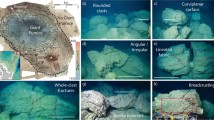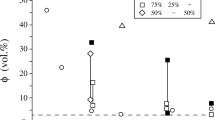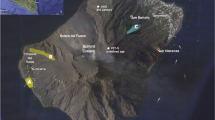Abstract
Silicic pumices formed during explosive volcanic eruptions are faithful recorders of the state of the magma in the conduit, close to or at the fragmentation level. We have characterized four types of pumices from the non-welded rhyolitic Kos Plateau Tuff, which erupted 161,000 years ago in the East Aegean Arc, Greece. The dominant type of pumice (>90 vol.%) shows highly elongated tubular vesicles. These tube pumices occur throughout the eruption. Less common pumice types include: (1) “frothy” pumice (highly porous with large, sub-rounded vesicles), which form 5–10 vol.% of the coarsest pyroclastic flow deposits, (2) dominantly “microvesicular” and systematically crystal-poor pumices, which are found in early erupted, fine-grained pyroclastic flow units, and are characterized by many small (<50 μm in diameter) vesicles and few mm-sized, irregular voids, (3) grey or banded pumices, indicating the interaction between the rhyolite and a more mafic magma, which are found throughout the eruption sequence and display highly irregular bubble shapes. Except for the grey-banded pumices, all three other types are compositionally identical and were generated synchronously as they are found in the same pyroclastic units. They, therefore, record different conditions in the volcanic conduit leading to variable bubble nucleation, growth and coalescence. A total of 74 pumice samples have been characterized using thin section observation, SEM imagery, porosimetry, and permeametry. We show that the four pumice types have distinct total and connected porosity, tortuosity and permeability. Grey-banded pumices show large variations in petrophysical characteristics as a response to mingling of two different magmas. The microvesicular, crystal-poor, pumices have a bimodal bubble size distribution, interpreted as reflecting an early heterogeneous bubble nucleation event followed by homogeneous bubble nucleation close to fragmentation. Finally, the significant differences in porosity, tortuosity and permeability in compositionally identical tube and frothy pumices are the result of variable shear rates in different parts of the conduit. Differential shear rates may be the result of either: (1) pure shear, inducing a vertical progression from frothy to tube and implying a relatively thick fragmentation zone to produce both types of pumices at the same time or (2) localized simple shear, inducing strongly tubular vesicles along the wall and near-spherical bubbles in the centre of the conduit and not necessarily requiring a thick fragmentation zone.












Similar content being viewed by others
References
Abell AB, Willis KL, Lange DA (1999) Mercury intrusion porosimetry and image analysis of cement-based materials. J Colloid Interface Sci 211(1):39–44
Allen SR (1998) Volcanology of the Kos Plateau Tuff, Greece: the product of an explosive eruption in an archipelago. PhD thesis, Monash University, Australia
Allen SR, Cas RAF (1998a) Lateral variations within coarse co-ignimbrite lithic breccias of the Kos Plateau Tuff, Greece. Bull Volcanol 59(5):356–377
Allen SR, Cas RAF (1998b) Rhyolitic fallout and pyroclastic density current deposits from a phreatoplinian eruption in the eastern Aegean Sea, Greece. J Volcanol Geotherm Res 86(1–4):219–251
Allen SR, Stadlbauer E, Keller J (1999) Stratigraphy of the Kos Plateau Tuff: product of a major quaternary explosive rhyolitic eruption in the eastern Aegean, Greece. Int J Earth Sci 88(1):132–156
Allen SR (2001) Reconstruction of a major caldera-forming eruption from pyroclastic deposit characteristics: Kos Plateau Tuff, eastern Aegean Sea. J Volcanol Geotherm Res 105(1–2):141–162
Bird RB, Stewart WE, Lightfoot EN (1960) Transport phenomena. Wiley, New York, p 780
Blower JD (2001) Factors controlling permeability–porosity relationships in magma. Bull Volcanol 63(7):497–504
Cas RAF, Wright JV (1988) Modern and ancient volcanic successions. Chapman&Hall, London, p 528
Dufek J, Bergantz GW (2007) Dynamics and deposits generated by the Kos Plateau Tuff eruption: controls of basal particle loss on pyroclastic flow transport. Geochem Geophys Geosyst 8(12):Q12007 doi:10.1029/2007gc001741
Eichelberger JC, Carrigan CR, Westrich HR, Price RH (1986) Nonexplosive silicic volcanism. Nature 323(6089):598–602
Forchheimer P (1901) Wasserbewegung durch Boden. Z Ver Dtsch Ing 45:1781–1788
Gardner JE, Thomas RME, Jaupart C, Tait S (1996) Fragmentation of magma during Plinian volcanic eruptions. Bull Volcanol 58(2–3):144–162
Ghiorso MS, Sack RO (1995) Chemical mass-transfer in magmatic processes IV: a revised and internally consistent thermodynamic model for the interpolation and extrapolation of liquid-solid equilibria in magmatic systems at elevated- temperatures and pressures. Contrib Mineral Petrol 119(2–3):197–212
Gonnermann HM, Manga M (2003) Explosive volcanism may not be an inevitable consequence of magma fragmentation. Nature 426(6965):432–435
Gonnermann HM, Manga M (2007) The fluid mechanics inside a volcano. Annu Rev Fluid Mech 39:321–356
Huang H, Ayoub J (2008) Applicability of the Forchheimer equation for non-Darcy flow in porous media. SPE Journal 13(1):112–122
Jaupart C, Allègre CJ (1991) Gas content, eruption rate and instabilities of eruption regime in silicic volcanoes. Earth Planet Sci Lett 102(3–4):413–429
Jaupart C (1998) Gas loss from magmas through conduit walls during eruption. Geol Soc Lond, Spec Publ 145(1):73–90
Jouniaux L, Bernard ML, Zamora M, Pozzi JP (2000) Streaming potential in volcanic rocks from Mount Pelee. J Geophys Res 105(B4):8391–8401
Klug C, Cashman KV (1996) Permeability development in vesiculating magmas: implications for fragmentation. Bull Volcanol 58(2–3):87–100
Klug C, Cashman KV, Bacon CR (2002) Structure and physical characteristics of pumice from the climactic eruption of Mount Mazama (Crater Lake), Oregon. Bull Volcanol 64(7):486–501
Llewellin EW, Mader HM, Wilson SDR (2002) The constitutive equation and flow dynamics of bubbly magmas. Geophys Res Lett 29(24):2170 doi:10.1029/2002gl015697
Mangan M, Mastin L, Sisson T (2004) Gas evolution in eruptive conduits: combining insights from high temperature and pressure decompression experiments with steady-state flow modeling. J Volcanol Geotherm Res 129(1–3):23–36
Marti J, Soriano C, Dingwell DB (1999) Tube pumices as strain markers of the ductile-brittle transition during magma fragmentation. Nature 402(6762):650–653
Massol H, Koyaguchi T (2005) The effect of magma flow on nucleation of gas bubbles in a volcanic conduit. J Volcanol Geotherm Res 143(1–3):69–88
Mastin LG (2005) The controlling effect of viscous dissipation on magma flow in silicic conduits. J Volcanol Geotherm Res 143(1–3):17–28
Melnik O (2000) Dynamics of two-phase conduit flow of high-viscosity gas-saturated magma: large variations of sustained explosive eruption intensity. Bull Volcanol 62(3):153–170
Melnik O, Sparks RSJ (2002) Dynamics of magma ascent and lava extrusion at Soufriere Hills Volcano, Montserrat. In: Druitt TH, Kokelaar BP (eds) The eruption of Soufriere Hills volcano, Montserrat, from 1995 to 1999. Geol Soc London Mem 21:153–171
Melnik O, Barmin AA, Sparks RSJ (2005) Dynamics of magma flow inside volcanic conduits with bubble overpressure buildup and gas loss through permeable magma. J Volcanol Geotherm Res 143(1–3):53–68
Mueller S, Melnik O, Spieler O, Scheu B, Dingwell DB (2005) Permeability and degassing of dome lavas undergoing rapid decompression: an experimental determination. Bull Volcanol 67(6):526–538
Okumura S, Nakamura M, Tsuchiyama A (2006) Shear-induced bubble coalescence in rhyolitic melts with low vesicularity. Geophys Res Lett 33(20):L20316 doi:10.1029/2006gl027347
Papale P (1999) Strain-induced magma fragmentation in explosive eruptions. Nature 397(6718):425–428
Papale P (2001) Dynamics of magma flow in volcanic conduits with variable fragmentation efficiency and nonequilibrium pumice degassing. J Geophys Res 106(B6):11043–11065
Polacci M, Papale P, Rosi M (2001) Textural heterogeneities in pumices from the climactic eruption of Mount Pinatubo, 15 June 1991, and implications for magma ascent dynamics. Bull Volcanol 63(2–3):83–97
Polacci M, Pioli L, Rosi M (2003) The Plinian phase of the Campanian Ignimbrite eruption (Phlegrean Fields, Italy): evidence from density measurements and textural characterization of pumice. Bull Volcanol 65(6):418–432
Roduit N (2006) JMicroVision: Image analysis toolbox for measuring and quantifying components of high-definition images. http://www.jmicrovision.com, Version 1.2.2
Rust AC, Manga M, Cashman KV (2003) Determining flow type, shear rate and shear stress in magmas from bubble shapes and orientations. J Volcanol Geotherm Res 122:111–132
Rust AC, Cashman KV (2004) Permeability of vesicular silicic magma: inertial and hysteresis effects. Earth Planet Sci Lett 228(1–2):93–107
Ruth D, Ma HP (1992) On the derivation of the forchheimer equation by means of the averaging theorem. Transport Porous Med 7(3):255–264
Saar MO, Manga M (1999) Permeability–porosity relationship in vesicular basalts. Geophys Res Lett 26(1):111–114
Salmas C, Androutsopoulos G (2001) Mercury porosimetry: contact angle hysteresis of materials with controlled pore structure. J Colloid Interface Sci 239(1):178–189
Slezin YB (2003) The mechanism of volcanic eruptions (a steady state approach). J Volcanol Geotherm Res 122(1–2):7–50
Smith PE, York D, Chen Y, Evensen NM (1996) Single crystal Ar-40-Ar-39 dating of a late quaternary paroxysm on Kos, Greece: concordance of terrestrial and marine ages. Geophys Res Lett 23(21):3047–3050
Sparks RSJ, Brazier S (1982) New evidence for degassing processes during explosive eruptions. Nature 295(5846):218–220
Stadlbauer E (1988) Vulkanologishe-geochemische analyse eines jungen ignimbrites: Der Kos-Plateau-Tuff (Südost-Ägäïs). PhD thesis, Freiburg
Stasiuk MV, Barclay J, Carroll MR, Jaupart C, Ratte JC, Sparks RSJ, Tait SR (1996) Degassing during magma ascent in the Mule Creek vent (USA). Bull Volcanol 58:117–130
Thomas N, Jaupart C, Vergniolle S (1994) On the vesicularity of pumice. J Geophys Res 99(B8):15633–15644
Whitham AG, Sparks RSJ (1986) Pumice. Bull Volcanol 48:209–223
Wilson CJN, Hildreth W (1997) The Bishop Tuff: new insights from eruptive stratigraphy. J Geol 105(4):407–439
Woods AW, Koyaguchi T (1994) Transitions between explosive and effusive eruptions of silicic magmas. Nature 370(6491):641–644
Wright HMN, Roberts JJ, Cashman KV (2006) Permeability of anisotropic tube pumice: model calculations and measurements. Geophys Res Lett 33(17):L17316 doi:10.1029/2006gl027224
Acknowledgments
We thank Ulrich Küppers and an anonymous reviewer for their critical comments and reviews that improved the manuscript. This project was supported by the Swiss NSF grant #2000-103441/1 to Bachmann. CBdM thanks the Bourse Lombard for contributing to field expenses. The Greek Institute of Geology & Mineral Exploration graciously provided a permit to work in the area. We thank Georges E. Vougioukalakis for his logistical guidance, E. Davaud for providing access to his petrophysical laboratory, G. Overney for his help with the permeameter, and J.M. Boccard for making the permeability standards.
Author information
Authors and Affiliations
Corresponding author
Additional information
Editorial responsibility: D. Dingwell
Appendix
Appendix
Rights and permissions
About this article
Cite this article
Bouvet de Maisonneuve, C., Bachmann, O. & Burgisser, A. Characterization of juvenile pyroclasts from the Kos Plateau Tuff (Aegean Arc): insights into the eruptive dynamics of a large rhyolitic eruption. Bull Volcanol 71, 643–658 (2009). https://doi.org/10.1007/s00445-008-0250-x
Received:
Accepted:
Published:
Issue Date:
DOI: https://doi.org/10.1007/s00445-008-0250-x




